SNAS521H July 2011 – January 2016 LMP90077 , LMP90078 , LMP90079 , LMP90080
PRODUCTION DATA.
- 1 Features
- 2 Applications
- 3 Description
- 4 Revision History
- 5 Description (continued)
- 6 Device Comparison Table
- 7 Pin Configuration and Functions
-
8 Specifications
- 8.1 Absolute Maximum Ratings
- 8.2 ESD Ratings
- 8.3 Recommended Operating Conditions
- 8.4 Thermal Information
- 8.5 Electrical Characteristics
- 8.6 Timing Requirements
- 8.7 Timing Requirements - CSB Timing
- 8.8 Timing Requirements - SCLK and SDI Timing
- 8.9 Timing Requirements - SDO Timing With DOD1
- 8.10 Timing Requirements - SDO Timing with DOD2
- 8.11 Timing Requirements - SDO and DRDYB Timing
- 8.12 Typical Characteristics
-
9 Detailed Description
- 9.1 Overview
- 9.2 Functional Block Diagram
- 9.3
Feature Description
- 9.3.1 Calibration
- 9.3.2 True Continuous Background Calibration
- 9.3.3 Continuous Background Sensor Diagnostics
- 9.3.4 Flexible Input MUX Channels
- 9.3.5 Programmable Gain Amplifiers (FGA & PGA)
- 9.3.6 Excitation Current Sources (IB1 & IB2) - LMP90080/LMP90078
- 9.3.7 Signal Path
- 9.4 Device Functional Modes
- 9.5
Programming
- 9.5.1 Serial Digital Interface
- 9.5.2 RESET and RESTART
- 9.5.3 Register Read/Write Examples
- 9.5.4 Streaming Examples
- 9.6 Register Maps
- 10Application and Implementation
- 11Power Supply Recommendations
- 12Layout
- 13Device and Documentation Support
- 14Mechanical, Packaging, and Orderable Information
Package Options
Mechanical Data (Package|Pins)
- PWP|28
Thermal pad, mechanical data (Package|Pins)
- PWP|28
Orderable Information
8 Specifications
8.1 Absolute Maximum Ratings
See (2)(1)(4)(5).| MIN | MAX | UNIT | ||
|---|---|---|---|---|
| Analog Supply Voltage, VA | –0.3 | 6.0 | V | |
| Digital I/O Supply Voltage, VIO | –0.3 | 6.0 | ||
| Reference Voltage, VREF | –0.3 | VA+0.3 | ||
| Voltage on Any Analog Input Pin to GND(3) | –0.3 | VA+0.3 | ||
| Voltage on Any Digital Input PIN to GND(3) | –0.3 | VIO+0.3 | ||
| Voltage on SDO(3) | –0.3 | VIO+0.3 | ||
| Input Current at Any Pin(3) | 5 | mA | ||
| Output Current Source or Sink by SDO | 5 | |||
| Total Package Input and Output Current | 20 | |||
| Junction Temperature (TJMAX) | 150 | °C | ||
| Storage Temperature (Tstg) | –65 | 150 | °C | |
(1) Stresses beyond those listed under Absolute Maximum Ratings may cause permanent damage to the device. These are stress ratings only, which do not imply functional operation of the device at these or any other conditions beyond those indicated under Recommended Operating Conditions. Exposure to absolute-maximum-rated conditions for extended periods may affect device reliability.
(2) All voltages are measured with respect to GND, unless otherwise specified
(3) When the input voltage (VIN) exceeds the power supply (VIN < GND or VIN > VA), the current at that pin must be limited to 5mA and VIN has to be within the Absolute Maximum Rating for that pin. The 20 mA package input current rating limits the number of pins that can safely exceed the power supplies with current flow to four pins.
(4) For soldering specifications see product folder at http://www.ti.com and http://www.ti.com/lit/SNOA549
(5) If Military/Aerospace specified devices are required, contact the Texas Instruments Sales Office/ Distributors for availability and specifications.
8.2 ESD Ratings
| VALUE | UNIT | |||
|---|---|---|---|---|
| V(ESD) | Electrostatic discharge | Human-body model (HBM), per ANSI/ESDA/JEDEC JS-001(1) | ±2500 | V |
| Charged-device model (CDM), per JEDEC specification JESD22-C101(2) | ±1250 | |||
| Machine models (MM) | ±200 | |||
(1) JEDEC document JEP155 states that 500-V HBM allows safe manufacturing with a standard ESD control process.
(2) JEDEC document JEP157 states that 250-V CDM allows safe manufacturing with a standard ESD control process.
8.3 Recommended Operating Conditions
| MIN | MAX | UNIT | |
|---|---|---|---|
| Analog Supply Voltage, VA | 2.85 | 5.5 | V |
| Digital I/O Supply Voltage, VIO | 2.7 | 5.5 | |
| Full Scale Input Range, VIN | ±VREF / PGA | ||
| Reference Voltage, VREF | 0.5 | VA | |
| Temperature Range for Electrical Characteristics | –40 | 125 | °C |
| Operating Temperature Range | –40 | 125 | |
| Junction to Ambient Thermal Resistance (RθJA)(1) | 41 | °C/W |
(1) The maximum power dissipation is a function of TJ(MAX) AND RθJA. The maximum allowable power dissipation at any ambient temperature is PD = (TJ(MAX) - TA) / RθJA.
8.4 Thermal Information
| THERMAL METRIC(1) | LMP900xx | UNIT | |
|---|---|---|---|
| HTSSOP (28 PINS) | |||
| RθJA | Junction-to-ambient thermal resistance | 41 | °C/W |
(1) For more information about traditional and new thermal metrics, see the IC Package Thermal Metrics application report, SPRA953.
8.5 Electrical Characteristics
Unless otherwise noted, the key for the condition is (VA = VIO = VREF) / ODR (SPS) / buffer / calibration / gain . The typical values apply for TA = +25°C.| PARAMETER | TEST CONDITIONS | MIN | TYP | MAX | UNIT | |
|---|---|---|---|---|---|---|
| n | Resolution | 16 | Bits | |||
| ENOB / NFR | Effective Number of Bits and Noise Free Resolution | 3V / all / ON / OFF / all. Shorted input. | See Table 1 | Bits | ||
| 5V / all / ON / OFF / all. Shorted input. | See Table 3 | Bits | ||||
| ODR | Output Data Rates | 1.6675 | See Table 1 | 214.6 | SPS | |
| Gain | FGA × PGA | 1 | See Table 3 | 128 | ||
| INL | Integral Non-Linearity(1) | 3V / 214.65 / ON / ON / 1 | -1 | ± 0.5 | +1 | LSB |
| 3V & 5V / 214.65 / ON / ON / 16 | ± 1 | LSB | ||||
| Total Noise | 3V / all / ON / ON / all. Shorted input. | See Table 2 | µV | |||
| 5V / all / ON / OFF / all. Shorted input. | See Table 4 | µV | ||||
| OE | Offset Error | 3V & 5V / all / ON or OFF / ON / all | Below Noise Floor (rms) | µV | ||
| 3V / 214.65 / ON / ON / 1 | 1.22 | 9.52 | µV | |||
| 3V / 214.65 / ON / ON / 128 | 0.00838 | 0.70 | µV | |||
| 5V / 214.65 / ON / ON / 1 | 1.79 | 8.25 | µV | |||
| 5V / 214.65 / ON / ON / 128 | 0.0112 | 0.63 | µV | |||
| Offset Drift Over Temp(1) | 3V & 5V / 214.65 / ON or OFF/OFF/1-8 | 100 | nV/°C | |||
| 3V & 5V / 214.65 / ON / ON / 1-8 | 3 | nV/°C | ||||
| 3V & 5V / 214.65 / ON / OFF / 16 | 25 | nV/°C | ||||
| 3V & 5V / 214.65 / ON / ON / 16 | 0.4 | nV/°C | ||||
| 3V & 5V / 214.65 / ON / OFF / 128 | 6 | nV/°C | ||||
| 3V & 5V / 214.65 / ON / ON / 128 | 0.125 | nV/°C | ||||
| Offset Drift over Time(1) | 5V / 214.65 / ON / OFF / 1, TA = 150°C | 2360 | nV/1000 hours | |||
| 5V / 214.65 / ON / ON / 1, TA = 150°C | 100 | nV/1000 hours | ||||
| GE | Gain Error(1) | 3V & 5V / 214.65 / ON / ON / 1, TMIN ≤ TA ≤ TMAX | -80 | 80 | ppm | |
| 3V & 5V / 214.65 / ON / ON / 1 | 7 | ppm | ||||
| 3V & 5V / 13.42 / ON / ON / 16 | 50 | ppm | ||||
| 3V & 5V / 13.42 / ON / ON / 64 | 50 | ppm | ||||
| 3V & 5V / 13.42 / ON / ON / 128 | 100 | ppm | ||||
| Gain Drift over Temp(1) | 3V & 5V / 214.65 / ON / ON / all | 0.5 | ppm/°C | |||
| Gain Drift over Time(1) | 5V / 214.65 / ON / OFF / 1, TA = 150°C | 5.9 | ppm/1000 hours | |||
| 5V / 214.65 / ON / ON / 1, TA = 150°C | 1.6 | ppm/1000 hours | ||||
| CONVERTER CHARACTERISTICS | ||||||
| CMRR | Input Common Mode Rejection Ratio | DC, 3V / 214.65 / ON / ON / 1, TMIN ≤ TA ≤ TMAX |
70 | dB | ||
| DC, 3V / 214.65 / ON / ON / 1 | 117 | dB | ||||
| DC, 5V / 214.65 / OFF / OFF / 1, TMIN ≤ TA ≤ TMAX |
90 | dB | ||||
| DC, 5V / 214.65 / OFF / OFF / 1 | 120 | dB | ||||
| 50/60 Hz, 5V / 214.65 / OFF / OFF / 1 | 117 | dB | ||||
| Reference Common Mode Rejection | VREF = 2.5V | 101 | dB | |||
| PSRR | Power Supply Rejection Ratio | DC, 3V / 214.65 / ON / ON / 1 | 75 | 115 | dB | |
| DC, 5V / 214.65 / ON / ON / 1 | 112 | dB | ||||
| NMRR | Normal Mode Rejection Ratio(1) | 47 Hz to 63 Hz, 5V / 13.42 / OFF / OFF / 1 TMIN ≤ TA ≤ TMAX |
95 | dB | ||
| Cross-talk(1) | 3V / 214.65 / OFF / OFF / 1, TMIN ≤ TA ≤ TMAX | 95 | dB | |||
| 3V / 214.65 / OFF / OFF / 1 | 136 | dB | ||||
| 5V / 214.65 / OFF / OFF / 1, TMIN ≤ TA ≤ TMAX | 95 | dB | ||||
| 5V / 214.65 / OFF / OFF / 1 | 143 | dB | ||||
| POWER SUPPLY CHARACTERISTICS | ||||||
| VA | Analog Supply Voltage | 2.85 | 3.0 | 5.5 | V | |
| VIO | Digital Supply Voltage | 2.7 | 3.3 | 5.5 | V | |
| IVA | Analog Supply Current | 3V / 13.42 / OFF / OFF / 1, ext. CLK | 400 | µA | ||
| 3V / 13.42 / OFF / OFF / 1, ext. CLK, TMIN ≤ TA ≤ TMAX |
500 | µA | ||||
| 5V / 13.42 / OFF / OFF / 1, ext. CLK | 464 | µA | ||||
| 5V / 13.42 / OFF / OFF / 1, ext. CLK, TMIN ≤ TA ≤ TMAX |
555 | µA | ||||
| 3V / 13.42 / ON / OFF / 64, ext. CLK | 600 | µA | ||||
| 3V / 13.42 / ON / OFF / 64, ext. CLK, TMIN ≤ TA ≤ TMAX |
700 | µA | ||||
| 5V / 13.42 / ON / OFF / 64, ext. CLK | 690 | µA | ||||
| 5V / 13.42 / ON / OFF / 64, ext. CLK, TMIN ≤ TA ≤ TMAX |
800 | µA | ||||
| 3V / 214.65 / ON / OFF / 64, int. CLK | 1547 | µA | ||||
| 3V / 214.65 / ON / OFF / 64, int. CLK, TMIN ≤ TA ≤ TMAX |
1700 | µA | ||||
| 5V / 214.65 / ON / OFF / 64, int. CLK | 1760 | µA | ||||
| 5V / 214.65 / ON / OFF / 64, int. CLK, TMIN ≤ TA ≤ TMAX |
2000 | µA | ||||
| 3V / 214.65 / OFF / OFF / 1, int. CLK | 826 | µA | ||||
| 3V / 214.65 / OFF / OFF / 1, int. CLK, TMIN ≤ TA ≤ TMAX |
1000 | µA | ||||
| 5V / 214.65 / OFF / OFF / 1, int. CLK | 941 | µA | ||||
| 5V / 214.65 / OFF / OFF / 1, int. CLK, TMIN ≤ TA ≤ TMAX |
1100 | µA | ||||
| Standby, 3V , int. CLK | 3 | 10 | µA | |||
| Standby, 3V , ext. CLK | 257 | µA | ||||
| Standby, 5V, int. CLK | 5 | 15 | µA | |||
| Standby, 3V, ext. CLK | 300 | µA | ||||
| Power-down, 3V, int/ext CLK | 2.6 | µA | ||||
| Power-down, 3V, int/ext CLK, TMIN ≤ TA ≤ TMAX | 5 | µA | ||||
| Power-down, 5V, int/ext CLK | 4.6 | µA | ||||
| Power-down, 5V, int/ext CLK, TMIN ≤ TA ≤ TMAX | 9 | µA | ||||
| REFERENCE INPUT | ||||||
| VREFP | Positive Reference | VREFN + 0.5 | VA | V | ||
| VREFN | Negative Reference | GND | VREFP - 0.5 | V | ||
| VREF | Differential Reference | VREF = VREFP - VREFN | 0.5 | VA | V | |
| ZREF | Reference Impedance | 3V / 13.42 / OFF / OFF / 1 | 10 | MΩ | ||
| IREF | Reference Input | 3V / 13.42 / ON or OFF /ON or OFF/all | ±2 | µA | ||
| CREFP | Capacitance of the Positive Reference | gain = 1(1) | 6 | pF | ||
| CREFN | Capacitance of the Negative Reference | gain = 1(1) | 6 | pF | ||
| ILREF | Reference Leakage Current | Power-down | 1 | nA | ||
| ANALOG INPUT | ||||||
| VINP | Positive Input | Gain = 1-8, buffer ON | GND + 0.1 | VA - 0.1 | V | |
| Gain = 16 - 128, buffer ON | GND + 0.4 | VA - 1.5 | V | |||
| Gain = 1-8, buffer OFF | GND | VA | V | |||
| VINN | Negative Input | Gain = 1-8, buffer ON | GND + 0.1 | VA - 0.1 | V | |
| Gain = 16 - 128, buffer ON | GND + 0.4 | VA - 1.5 | V | |||
| Gain = 1-8, buffer OFF | GND | VA | V | |||
| VIN | Differential Input | VIN = VINP - VINN | ±VREF / PGA | |||
| ZIN | Differential Input Impedance | ODR = 13.42 SPS | 15.4 | MΩ | ||
| CINP | Capacitance of the Positive Input | 5V / 214.65 / OFF / OFF / 1 | 4 | pF | ||
| CINN | Capacitance of the Negative Input | 5V / 214.65 / OFF / OFF / 1 | 4 | pF | ||
| IIN | Input Leakage Current | 3V & 5V / 13.42 / ON / OFF / 1-8 | 500 | pA | ||
| 3V & 5V / 13.42 / ON / OFF / 16 - 128 | 100 | pA | ||||
| DIGITAL INPUT CHARACTERISTICS at VA = VIO = VREF = 3.0 V | ||||||
| VIH | Logical "1" Input Voltage | 0.7 x VIO | V | |||
| VIL | Logical "0" Input Voltage | 0.3 x VIO | V | |||
| IIL | Digital Input Leakage Current | -10 | +10 | µA | ||
| VHYST | Digital Input Hysteresis | 0.1 x VIO | V | |||
| DIGITAL OUTPUT CHARACTERISTICS at VA = VIO = VREF = 3.0 V | ||||||
| VOH | Logical "1" Output Voltage | Source 300 µA | 2.6 | V | ||
| VOL | Logical "0" Output Voltage | Sink 300 µA | 0.4 | V | ||
| IOZH, IOZL | TRI-STATE Leakage Current | -10 | 10 | µA | ||
| COUT | TRI-STATE Capacitance | See(1) | 5 | pF | ||
| EXCITATION CURRENT SOURCES CHARACTERISTICS (LMP90080/LMP90078 ONLY) | ||||||
| IB1, IB2 | Excitation Current Source Output | 0, 100, 200, 300, 400, 500, 600, 700, 800, 900, 1000 | µA | |||
| IB1/IB2 Tolerance | VA = VREF = 3V | 2.5% | ||||
| VA = VREF = 3V, TMIN ≤ TA ≤ TMAX | -7% | 7% | ||||
| VA = VREF = 5V | 0.2% | |||||
| VA = VREF = 5V, TMIN ≤ TA ≤ TMAX | -3.5% | 3.5% | ||||
| IB1/IB2 Output Compliance Range | VA = 3.0V & 5.0V, IB1/IB2 = 100 µA to 1000 µA | VA - 0.8 | V | |||
| IB1/IB2 Regulation | VA = 5.0V, IB1/IB2 = 100 µA to 1000 µA | 0.07 | %/V | |||
| IBTC | IB1/IB2 Drift | VA = 3.0V | 95 | ppm/°C | ||
| VA = 5.0V | 60 | ppm/°C | ||||
| IBMT | IB1/IB2 Matching | 3V & 5V / 214.65 / OFF / OFF / 1, IB1/IB2 = 100 µA |
0.34% | |||
| 3V & 5V / 214.65 / OFF / OFF / 1, IB1/IB2 = 100 µA, TMIN ≤ TA ≤ TMAX |
1.53% | |||||
| 3V & 5V / 214.65 / OFF / OFF / 1, IB1/IB2 = 200 µA |
0.22% | |||||
| 3V & 5V / 214.65 / OFF / OFF / 1, IB1/IB2 = 200 µA, TMIN ≤ TA ≤ TMAX |
1% | |||||
| 3V & 5V / 214.65 / OFF / OFF / 1, IB1/IB2 = 300 µA |
0.2% | |||||
| 3V & 5V / 214.65 / OFF / OFF / 1, IB1/IB2 = 300 µA, TMIN ≤ TA ≤ TMAX |
0.85% | |||||
| 3V & 5V / 214.65 / OFF / OFF / 1, IB1/IB2 = 400 µA |
0.15% | |||||
| 3V & 5V / 214.65 / OFF / OFF / 1, IB1/IB2 = 400 µA, TMIN ≤ TA ≤ TMAX |
0.8% | |||||
| 3V & 5V / 214.65 / OFF / OFF / 1, IB1/IB2 = 500 µA |
0.14% | |||||
| 3V & 5V / 214.65 / OFF / OFF / 1, IB1/IB2 = 500 µA, TMIN ≤ TA ≤ TMAX |
0.7% | |||||
| 3V & 5V / 214.65 / OFF / OFF / 1, IB1/IB2 = 600 µA |
0.13% | |||||
| 3V & 5V / 214.65 / OFF / OFF / 1, IB1/IB2 = 600 µA, TMIN ≤ TA ≤ TMAX |
0.7% | |||||
| 3V & 5V / 214.65 / OFF / OFF / 1, IB1/IB2 = 700 µA |
0.075% | |||||
| 3V & 5V / 214.65 / OFF / OFF / 1, IB1/IB2 = 700 µA, TMIN ≤ TA ≤ TMAX |
0.65% | |||||
| 3V & 5V / 214.65 / OFF / OFF / 1, IB1/IB2 = 800 µA |
0.085% | |||||
| 3V & 5V / 214.65 / OFF / OFF / 1, IB1/IB2 = 800 µA, TMIN ≤ TA ≤ TMAX |
0.6% | |||||
| 3V & 5V / 214.65 / OFF / OFF / 1, IB1/IB2 = 900 µA |
0.11% | |||||
| 3V & 5V / 214.65 / OFF / OFF / 1, IB1/IB2 = 900 µA,TMIN ≤ TA ≤ TMAX |
0.55% | |||||
| 3V & 5V / 214.65 / OFF / OFF / 1, IB1/IB2 = 1000 µA |
0.11% | |||||
| 3V & 5V / 214.65 / OFF / OFF / 1, IB1/IB2 = 1000 µA, TMIN ≤ TA ≤ TMAX |
0.45% | |||||
| IBMTC | IB1/IB2 Matching Drfit | VA = 3.0V & 5.0V, IB1/IB2 = 100 µA to 1000 µA | 2 | ppm/°C | ||
| INTERNAL/EXTERNAL CLK | ||||||
| CLKIN | Internal Clock Frequency | 893 | kHz | |||
| CLKEXT | External Clock Frequency | See(1) | 1.8 | 3.5717 | 7.2 | MHz |
| External Crystal Frequency | Input Low Voltage | 0 | V | |||
| Input High Voltage | 1 | V | ||||
| Frequency | 1.8 | 3.5717 | 7.2 | MHz | ||
| Start-up time | 7 | ms | ||||
| SCLK | Serial Clock | 10 | MHz | |||
(1) This parameter is specified by design and/or characterization and is not tested in production.
8.6 Timing Requirements
Unless otherwise noted, specified limits apply for VA = VIO = 3 V. The typical values apply for TA = 25°C.| MIN | NOM | MAX | UNIT | |||
|---|---|---|---|---|---|---|
| fSCLK | See Figure 1. | 10 | MHz | |||
| tCH | SCLK High time | 0.4 / fSCLK | ns | |||
| tCL | SCLK Low time | 0.4 / fSCLK | ns | |||
8.7 Timing Requirements - CSB Timing
| MIN | NOM | MAX | UNIT | |||
|---|---|---|---|---|---|---|
| tCSSU | CSB Setup time prior to an SCLK rising edge | See Figure 2. | 5 | ns | ||
| tCSH | CSB Hold time after the last rising edge of SCLK | See Figure 3. | 6 | ns | ||
8.8 Timing Requirements - SCLK and SDI Timing
| MIN | NOM | MAX | UNIT | |||
|---|---|---|---|---|---|---|
| tCLKR | SCLK Rise time | See Figure 4. | 1.15 | ns | ||
| tCLKF | SCLK Fall time | 1.15 | ns | |||
| tDISU | SDI Setup time prior to an SCLK rising edge | See Figure 5. | 5 | ns | ||
| tDIH | SDI Hold time after an SCLK rising edge | 6 | ns | |||
8.9 Timing Requirements - SDO Timing With DOD1
| MIN | NOM | MAX | UNIT | ||||
|---|---|---|---|---|---|---|---|
| tDOA | SDO Access time after an SCLK falling edge | See Figure 6. | 35 | ns | |||
| tDOH | SDO Hold time after an SCLK falling edge | 5 | ns | ||||
| tDOD1 | SDO Disable time after the rising edge of CSB | See Figure 7. | 27 | ns | |||
8.10 Timing Requirements - SDO Timing with DOD2
| MIN | NOM | MAX | UNIT | ||||
|---|---|---|---|---|---|---|---|
| tDOD2 | SDO Disable time after either edge of SCLK | See Figure 8 and Figure 9. | 27 | ns | |||
8.11 Timing Requirements - SDO and DRDYB Timing
| MIN | NOM | MAX | UNIT | |||
|---|---|---|---|---|---|---|
| tDOE | SDO Enable time from the falling edge of the 8th SCLK | See Figure 10. | 35 | ns | ||
| tDOR | SDO Rise time(1) | See Figure 11. | 7 | ns | ||
| tDOF | SDO Fall time(1) | 7 | ns | |||
| tDRDYB | Data Ready Bar pulse at every 1/ODR second |
ODR ≤ 13.42 SPS | 64 | µs | ||
| 13.42 < ODR ≤ 214.65 SPS | 4 | µs | ||||
(1) This parameter is specified by design and/or characterization and is not tested in production.
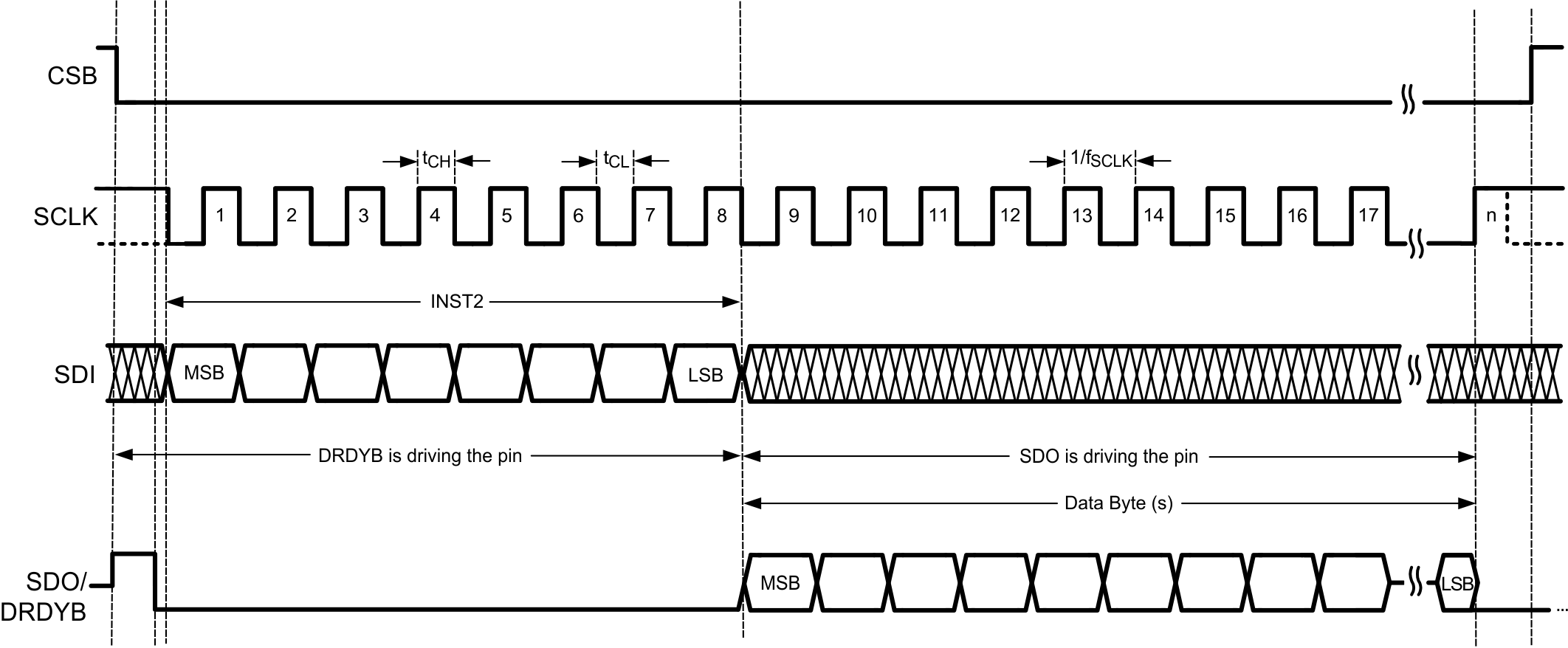 Figure 1. Timing Diagram
Figure 1. Timing Diagram
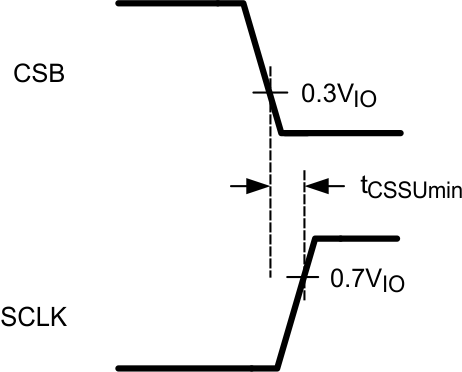 Figure 2. CBS Setup Time
Figure 2. CBS Setup Time
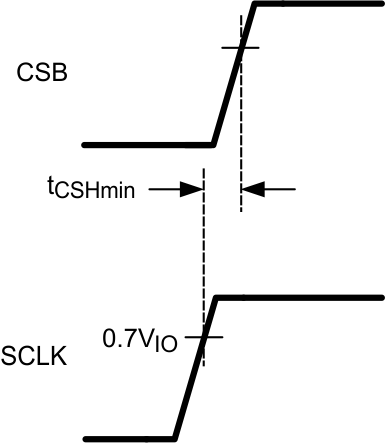 Figure 3. CBS Hold Time
Figure 3. CBS Hold Time
 Figure 4. SCLK Rise and Fall Time
Figure 4. SCLK Rise and Fall Time
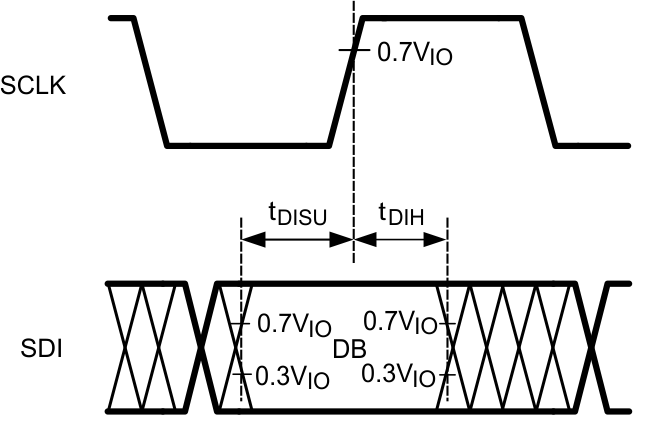 Figure 5. SCLK Setup and Hold Time
Figure 5. SCLK Setup and Hold Time
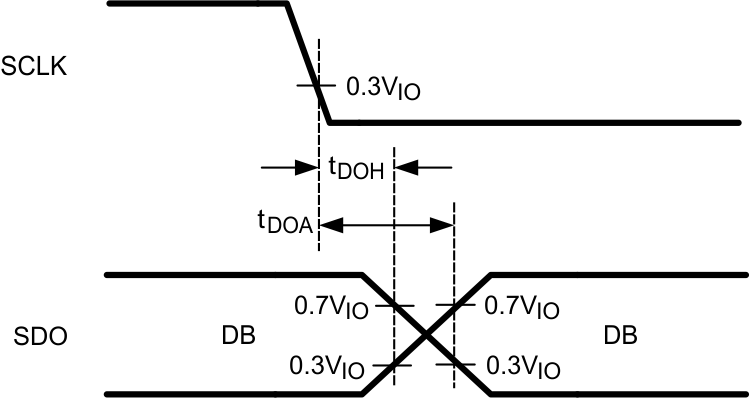 Figure 6. SDO Enable Time
Figure 6. SDO Enable Time
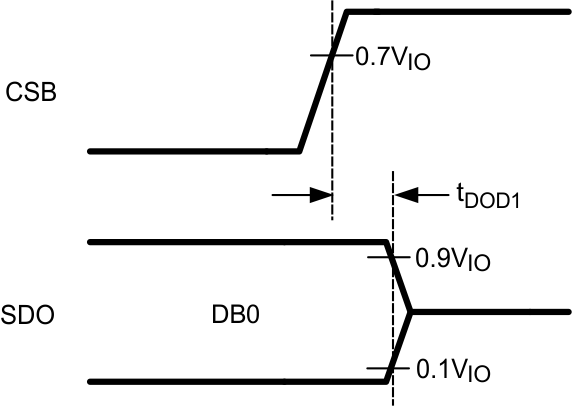 Figure 7. SDO Rise and Fall Time
Figure 7. SDO Rise and Fall Time
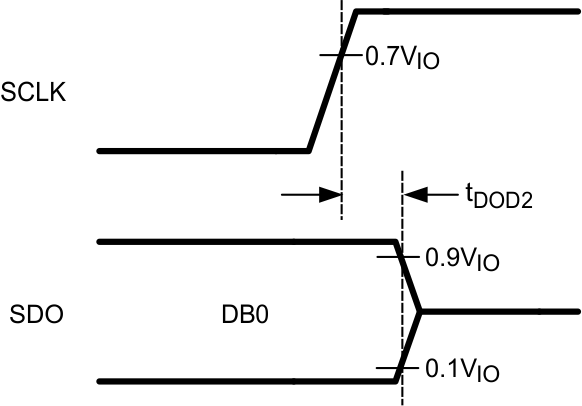 Figure 8. SDO Disable Time
Figure 8. SDO Disable Time
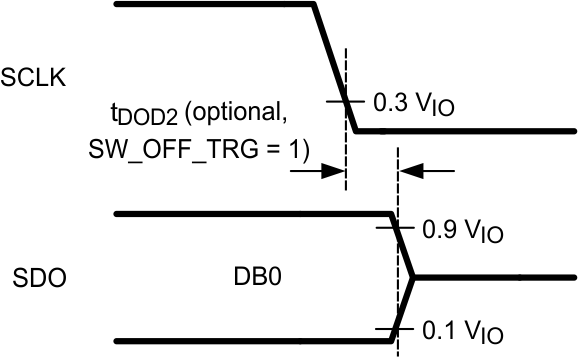 Figure 9. SDO Rise and Fall Time
Figure 9. SDO Rise and Fall Time
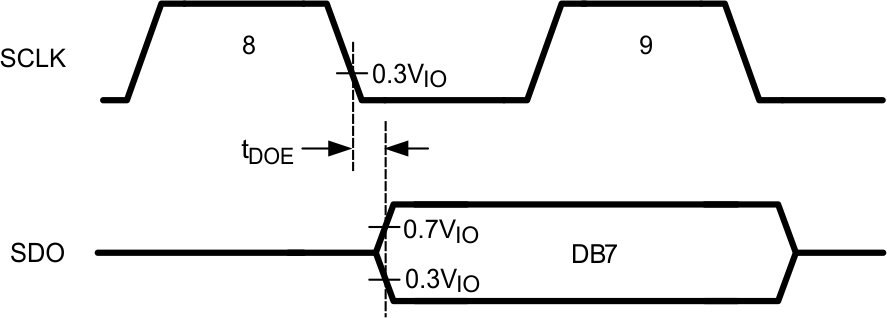 Figure 10. SDO Enable Time
Figure 10. SDO Enable Time
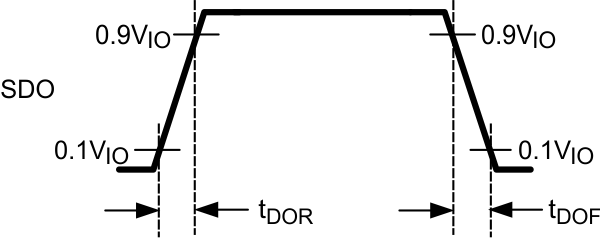 Figure 11. SDO Rise and Fall Time
Figure 11. SDO Rise and Fall Time
Table 1. ENOB (Noise Free Resolution) vs Sampling Rate and Gain At VA = VIO = VREF = 3V
| ODR (SPS) | GAIN | |||||||
|---|---|---|---|---|---|---|---|---|
| 1 | 2 | 4 | 8 | 16 | 32 | 64 | 128 | |
| 1.6775 | 16 (16) | 16 (16) | 16 (16) | 16 (16) | 16 (16) | 16 (16) | 16 (16) | 16 (15.5) |
| 3.355 | 16 (16) | 16 (16) | 16 (16) | 16 (16) | 16 (16) | 16 (16) | 16 (16) | 16 (14.5) |
| 6.71 | 16 (16) | 16 (16) | 16 (16) | 16 (15.5) | 16 (16) | 16 (16) | 16 (15) | 16 (14.5) |
| 13.42 | 16 (16) | 16 (16) | 16 (15.5) | 16 (15) | 16 (16) | 16 (15.5) | 16 (15) | 16 (14) |
| 26.83125 | 16 (16) | 16 (16) | 16 (16) | 16 (16) | 16 (16) | 16 (16) | 16 (15.5) | 16 (15) |
| 53.6625 | 16 (16) | 16 (16) | 16 (16) | 16 (16) | 16 (16) | 16 (16) | 16 (15) | 16 (14.5) |
| 107.325 | 16 (16) | 16 (16) | 16 (16) | 16 (15.5) | 16 (16) | 16 (15.5) | 16 (14.5) | 16 (14) |
| 214.65 | 16 (16) | 16 (16) | 16 (15.5) | 16 (15) | 16 (16) | 16 (15) | 16 (14.5) | 16 (13.5) |
Table 2. RMS Noise (mV) vs Sampling Rate and Gain At VA = VIO = VREF = 3V
| ODR (SPS) | GAIN OF THE ADC | |||||||
|---|---|---|---|---|---|---|---|---|
| 1 | 2 | 4 | 8 | 16 | 32 | 64 | 128 | |
| 1.6775 | 3.08 | 1.90 | 1.53 | 1.27 | 0.23 | 0.21 | 0.15 | 0.14 |
| 3.355 | 4.56 | 2.70 | 2.21 | 1.67 | 0.34 | 0.27 | 0.24 | 0.26 |
| 6.71 | 6.15 | 4.10 | 3.16 | 2.39 | 0.51 | 0.40 | 0.37 | 0.35 |
| 13.42 | 8.60 | 5.85 | 4.29 | 3.64 | 0.67 | 0.54 | 0.51 | 0.49 |
| 26.83125 | 3.35 | 2.24 | 1.65 | 1.33 | 0.33 | 0.27 | 0.26 | 0.25 |
| 53.6625 | 4.81 | 3.11 | 2.37 | 1.90 | 0.44 | 0.39 | 0.37 | 0.36 |
| 107.325 | 6.74 | 4.51 | 3.38 | 2.66 | 0.63 | 0.54 | 0.52 | 0.49 |
| 214.65 | 9.52 | 6.37 | 4.72 | 3.79 | 0.90 | 0.79 | 0.72 | 0.70 |
Table 3. ENOB (Noise Free Resolution) vs Sampling Rate and Gain At VA = VIO = VREF = 5V
| SPS | GAIN OF THE ADC | |||||||
|---|---|---|---|---|---|---|---|---|
| 1 | 2 | 4 | 8 | 16 | 32 | 64 | 128 | |
| 1.6775 | 16 (16) | 16 (16) | 16 (16) | 16 (16) | 16 (16) | 16 (16) | 16 (16) | 16 (16) |
| 3.355 | 16 (16) | 16 (16) | 16 (16) | 16 (16) | 16 (16) | 16 (16) | 16 (16) | 16 (15.5) |
| 6.71 | 16 (16) | 16 (16) | 16 (16) | 16 (16) | 16 (16) | 16 (16) | 16 (16) | 16 (15) |
| 13.42 | 16 (16) | 16 (16) | 16 (16) | 16 (16) | 16 (16) | 16 (16) | 16 (15.5) | 16 (15) |
| 26.83125 | 16 (16) | 16 (16) | 16 (16) | 16 (16) | 16 (16) | 16 (16) | 16 (16) | 16 (15.5) |
| 53.6625 | 16 (16) | 16 (16) | 16 (16) | 16 (16) | 16 (16) | 16 (16) | 16 (16) | 16 (15) |
| 107.325 | 16 (16) | 16 (16) | 16 (16) | 16 (16) | 16 (16) | 16 (16) | 16 (15.5) | 16 (14.5) |
| 214.65 | 16 (16) | 16 (16) | 16 (16) | 16 (16) | 16 (16) | 16 (16) | 16 (15) | 16 (14) |
Table 4. RMS Noise (mV) vs. Sampling Rate and Gain At VA = VIO = VREF = 5V
| SPS | GAIN OF THE ADC | |||||||
|---|---|---|---|---|---|---|---|---|
| 1 | 2 | 4 | 8 | 16 | 32 | 64 | 128 | |
| 1.6775 | 2.68 | 1.65 | 1.24 | 1.00 | 0.22 | 0.19 | 0.17 | 0.16 |
| 3.355 | 3.86 | 2.36 | 1.78 | 1.47 | 0.34 | 0.27 | 0.22 | 0.22 |
| 6.71 | 5.23 | 3.49 | 2.47 | 2.09 | 0.44 | 0.34 | 0.30 | 0.32 |
| 13.42 | 7.94 | 5.01 | 3.74 | 2.94 | 0.61 | 0.50 | 0.45 | 0.43 |
| 26.83125 | 2.90 | 1.86 | 1.34 | 1.08 | 0.29 | 0.24 | 0.23 | 0.23 |
| 53.6625 | 4.11 | 2.60 | 1.90 | 1.50 | 0.39 | 0.35 | 0.32 | 0.31 |
| 107.325 | 5.74 | 3.72 | 2.72 | 2.11 | 0.56 | 0.48 | 0.46 | 0.44 |
| 214.65 | 8.25 | 5.31 | 3.82 | 2.97 | 0.79 | 0.68 | 0.64 | 0.63 |
8.12 Typical Characteristics
Unless otherwise noted, specified limits apply for VA = VIO = VREF = 3.0 V. The maximum and minimum values apply for TA = TMIN to TMAX; the typical values apply for TA = 25°C.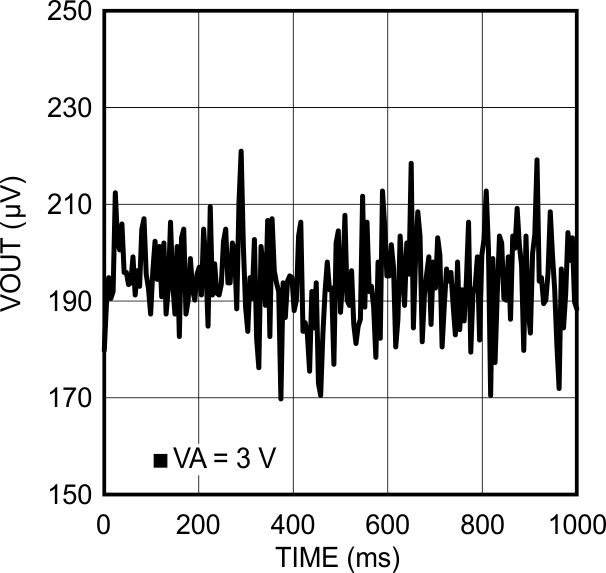 Figure 12. Noise Measurement Without Calibration
Figure 12. Noise Measurement Without Calibration at Gain = 1
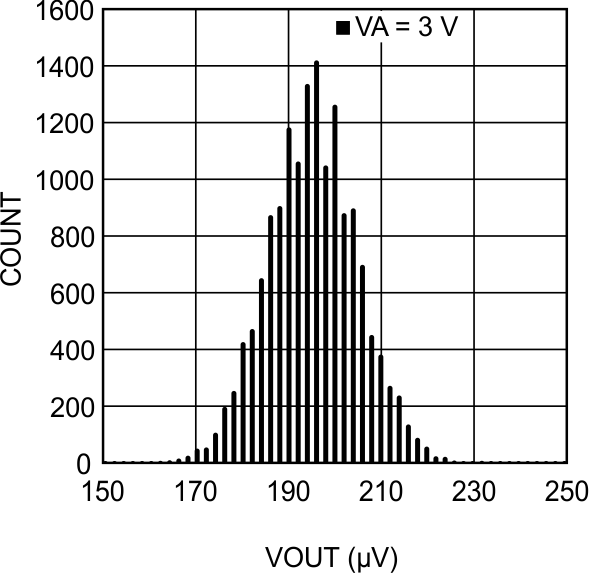 Figure 14. Histogram Without Calibration
Figure 14. Histogram Without Calibration at Gain = 1
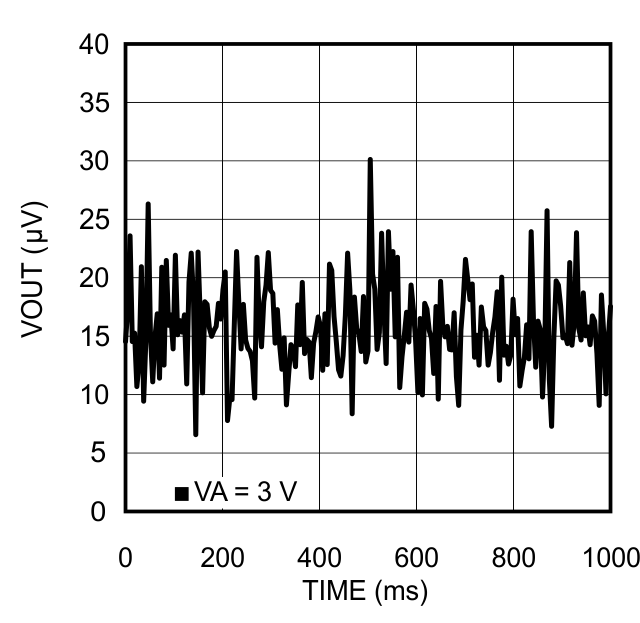 Figure 16. Noise Measurement Without Calibration
Figure 16. Noise Measurement Without Calibration at Gain = 8
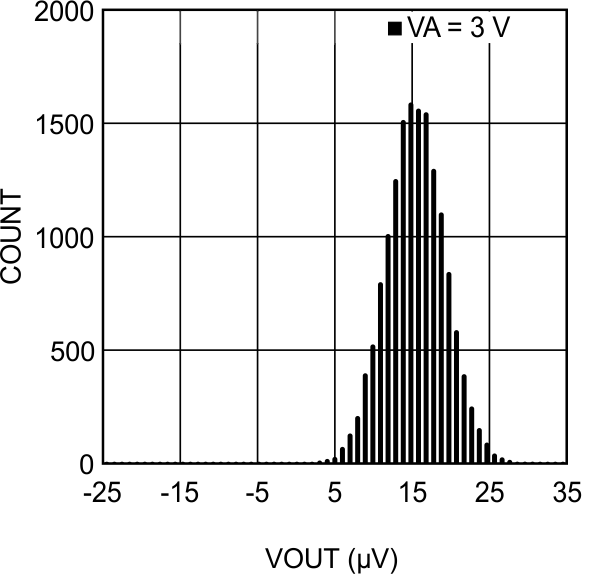 Figure 18. Histogram Without Calibration
Figure 18. Histogram Without Calibration at Gain = 8
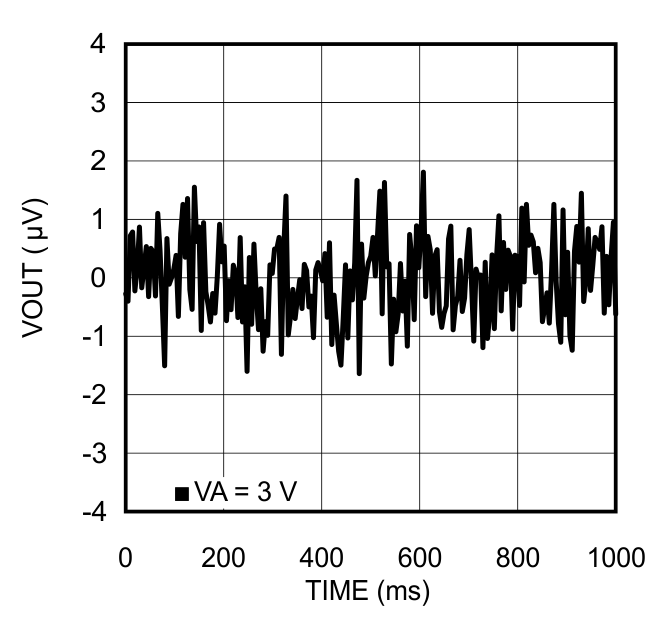 Figure 20. Noise Measurement Without Calibration
Figure 20. Noise Measurement Without Calibration at Gain = 128
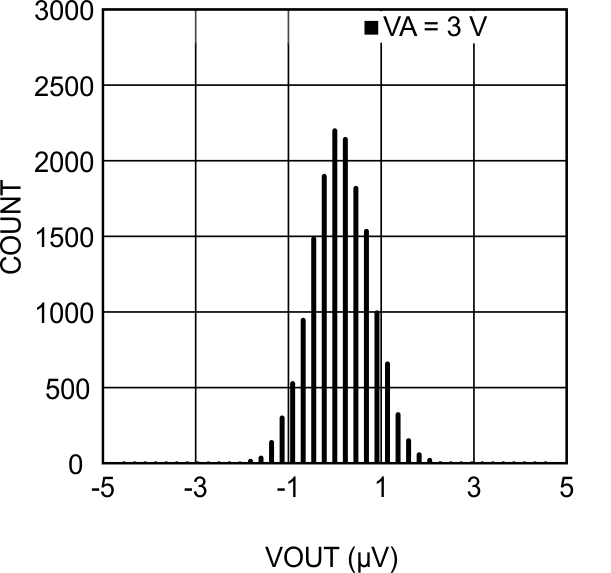 Figure 22. Histogram Without Calibration
Figure 22. Histogram Without Calibration at Gain = 128
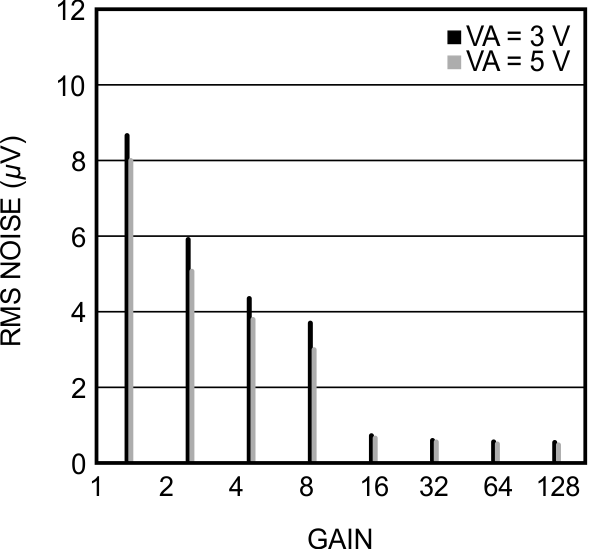 Figure 24. Noise vs. Gain Without Calibration
Figure 24. Noise vs. Gain Without Calibration at ODR = 13.42 SPS
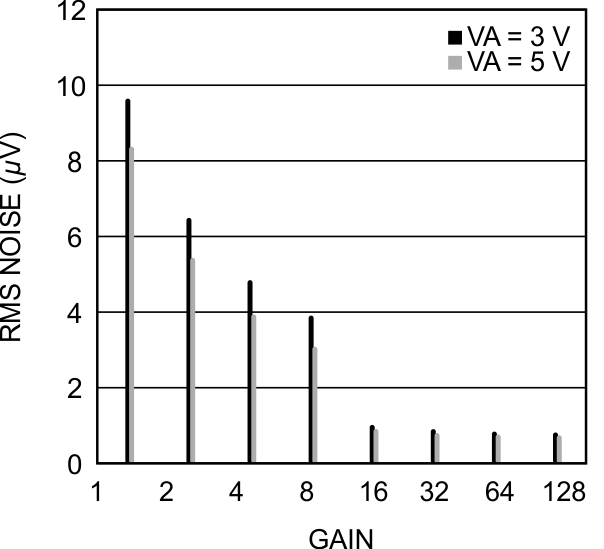 Figure 26. Noise vs. Gain Without Calibration
Figure 26. Noise vs. Gain Without Calibration at ODR = 214.65 SPS
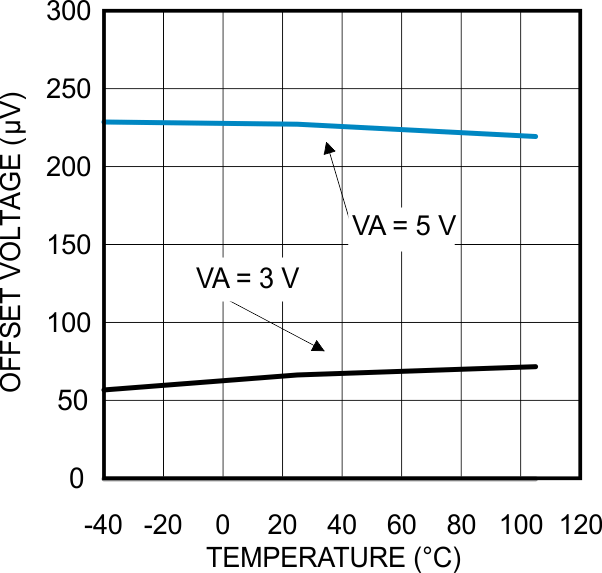 Figure 28. Offset Error vs. Temperature Without Calibration
Figure 28. Offset Error vs. Temperature Without Calibration at Gain = 1
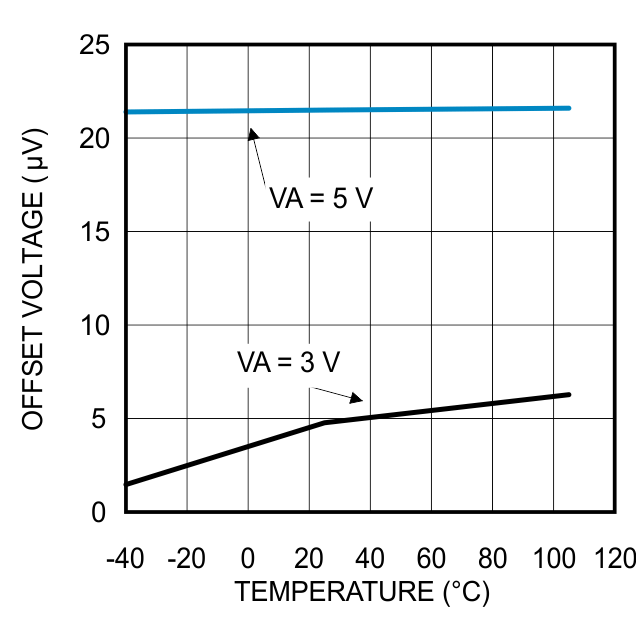 Figure 30. Offset Error vs. Temperature Without Calibration
Figure 30. Offset Error vs. Temperature Without Calibration at Gain = 8
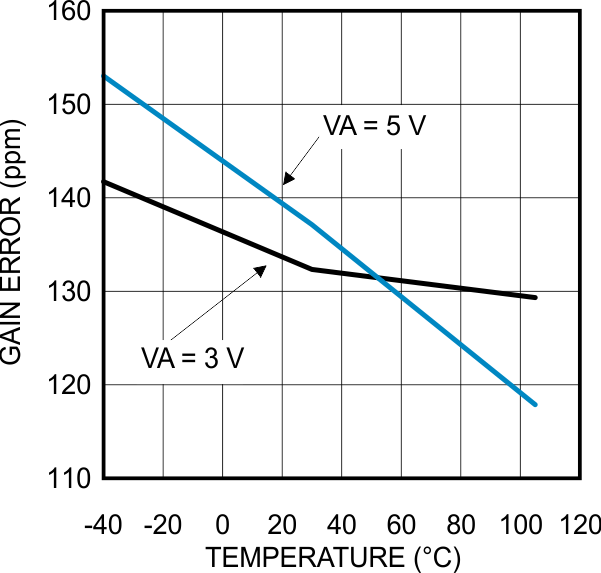 Figure 32. Gain Error vs. Temperature Without Calibration
Figure 32. Gain Error vs. Temperature Without Calibration at Gain = 1
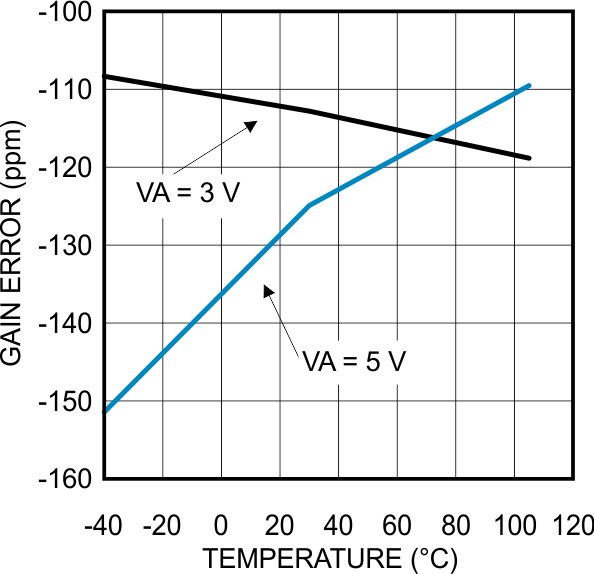 Figure 34. Gain Error vs. Temperature Without Calibration
Figure 34. Gain Error vs. Temperature Without Calibration at Gain = 8
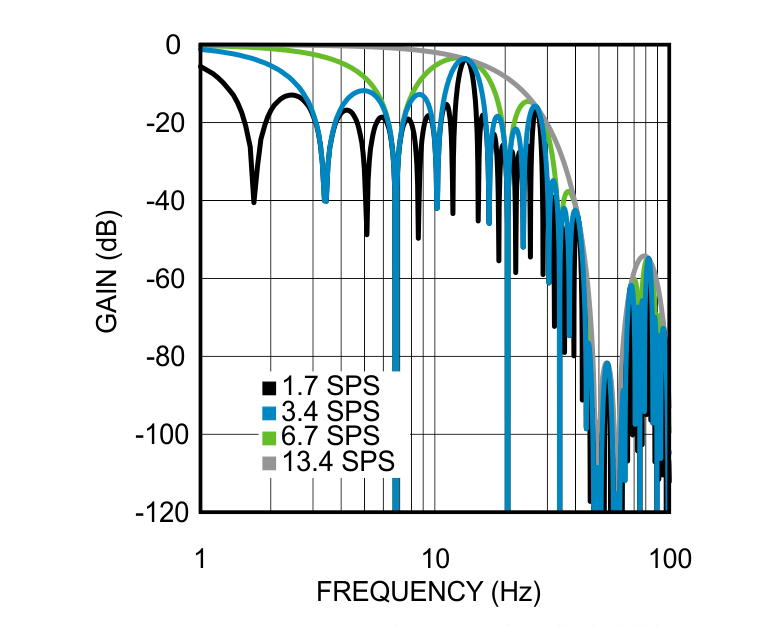 Figure 36. Digital Filter Frequency Response
Figure 36. Digital Filter Frequency Response
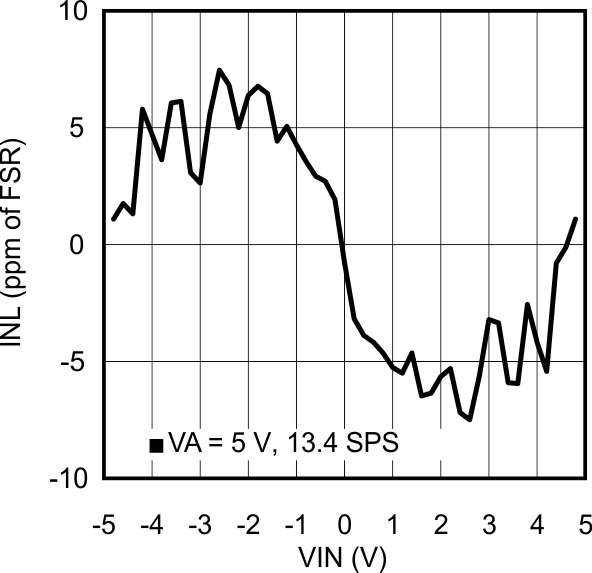 Figure 38. INL at Gain = 1
Figure 38. INL at Gain = 1
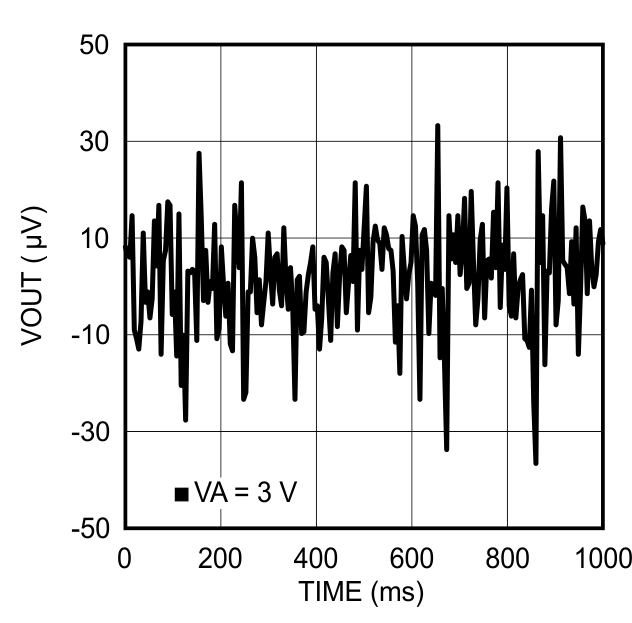 Figure 13. Noise Measurement With Calibration
Figure 13. Noise Measurement With Calibration at Gain = 1
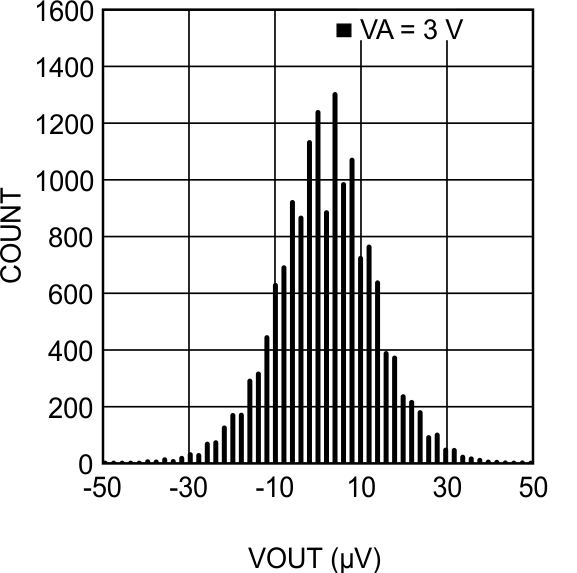 Figure 15. Histogram With Calibration
Figure 15. Histogram With Calibration at Gain = 1
 Figure 17. Noise Measurement With Calibration
Figure 17. Noise Measurement With Calibration at Gain = 8
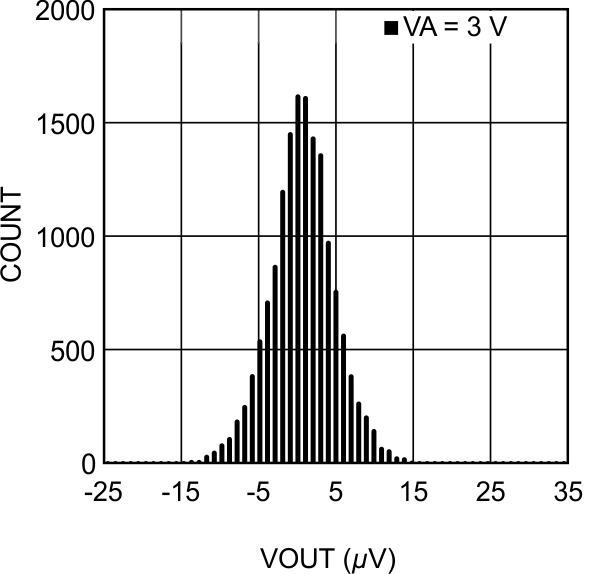 Figure 19. Histogram With Calibration
Figure 19. Histogram With Calibration at Gain = 8
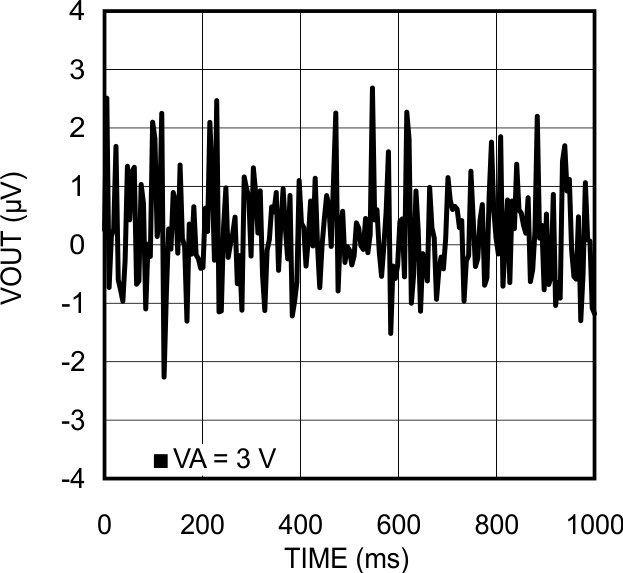 Figure 21. Noise Measurement With Calibration
Figure 21. Noise Measurement With Calibration at Gain = 128
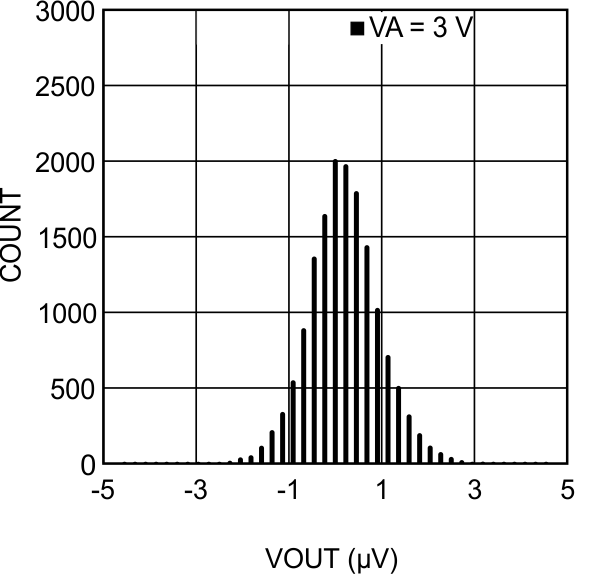 Figure 23. Histogram With Calibration
Figure 23. Histogram With Calibration at Gain = 128
 Figure 25. Noise vs. Gain With Calibration
Figure 25. Noise vs. Gain With Calibration at ODR = 13.42 SPS
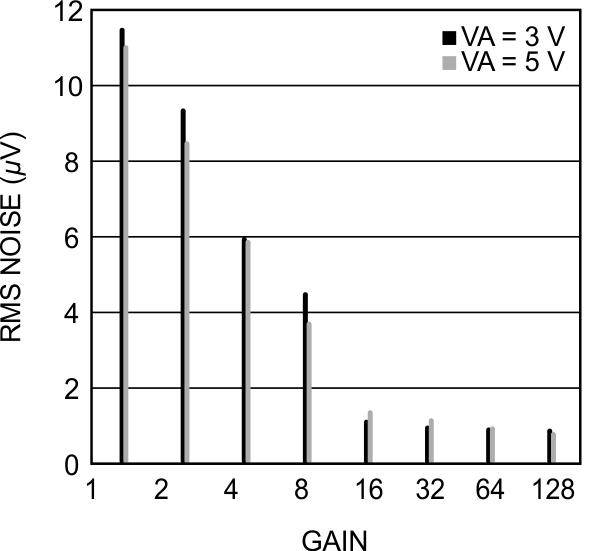 Figure 27. Noise vs. Gain With Calibration
Figure 27. Noise vs. Gain With Calibration at ODR = 214.65 SPS
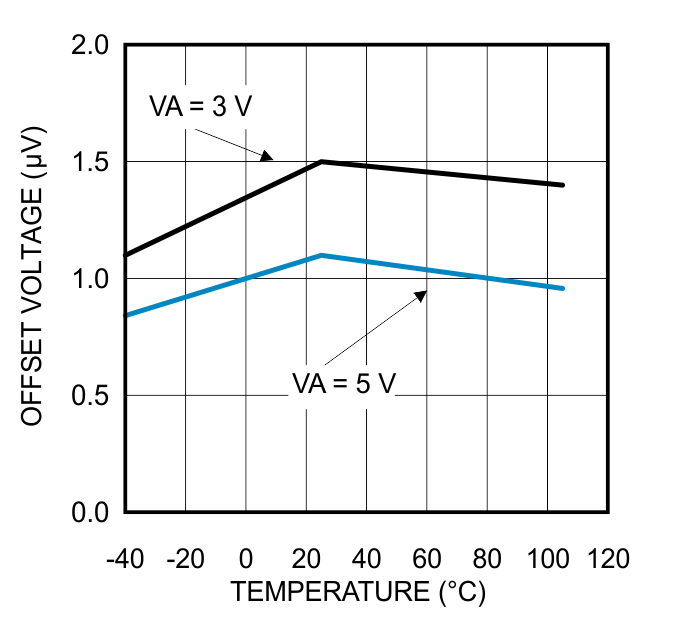 Figure 29. Offset Error vs. Temperature With Calibration
Figure 29. Offset Error vs. Temperature With Calibration at Gain = 1
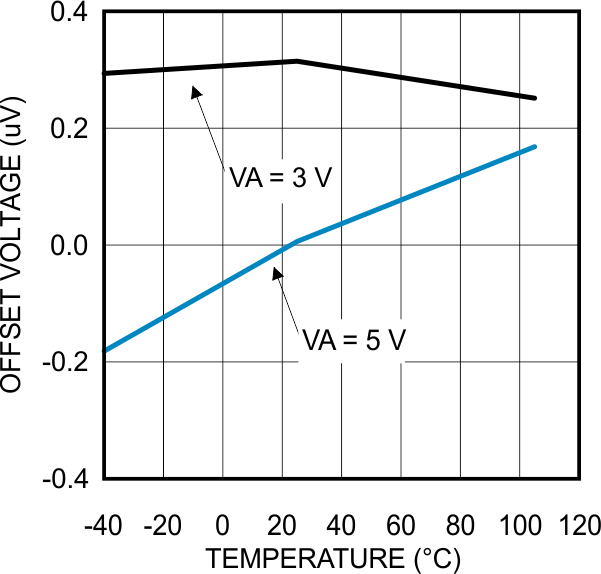 Figure 31. Offset Error vs. Temperature With Calibration
Figure 31. Offset Error vs. Temperature With Calibration at Gain = 8
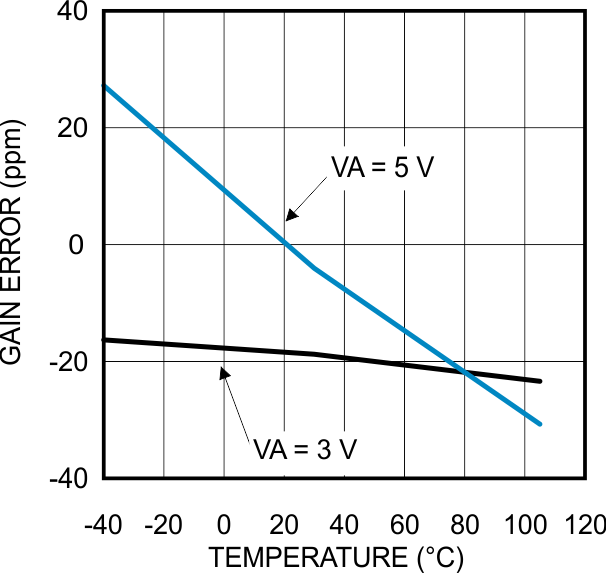 Figure 33. Gain Error vs. Temperature With Calibration
Figure 33. Gain Error vs. Temperature With Calibration at Gain = 1
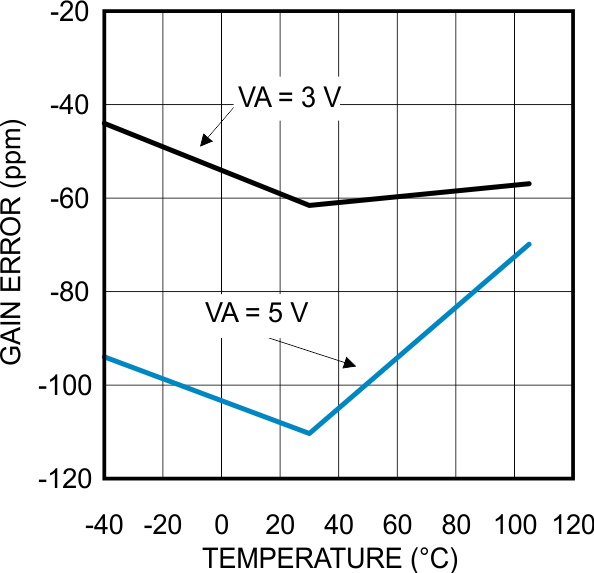 Figure 35. Gain Error vs. Temperature With Calibration
Figure 35. Gain Error vs. Temperature With Calibration at Gain = 8
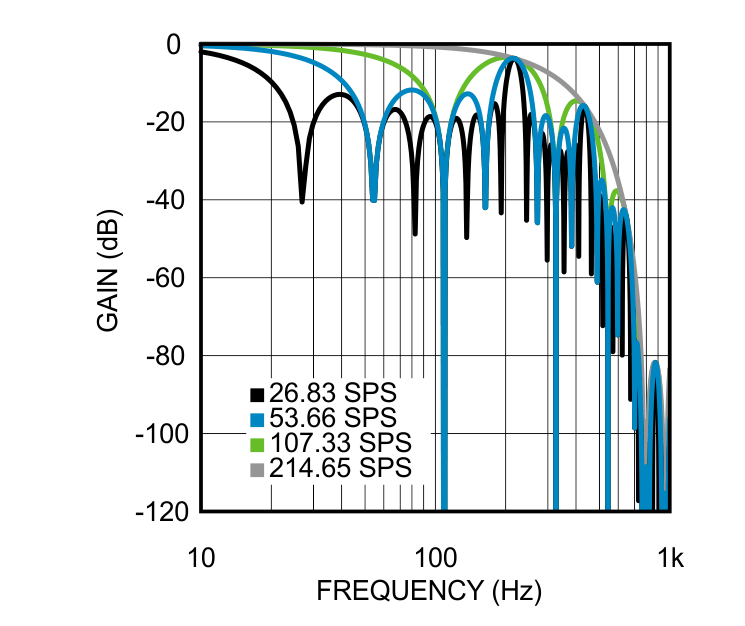 Figure 37. Digital Filter Frequency Response
Figure 37. Digital Filter Frequency Response